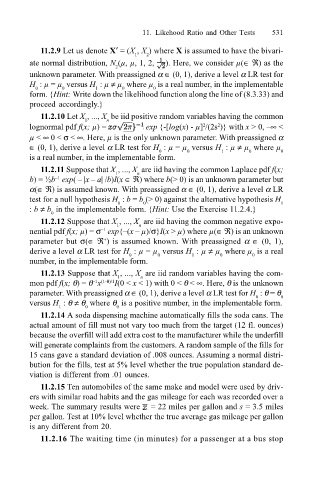Page 554 - Probability and Statistical Inference
P. 554
11. Likehood Ratio and Other Tests 531
11.2.9 Let us denote X′ = (X , X ) where X is assumed to have the bivari-
1 2
ate normal distribution, N (µ, µ, 1, 2, ). Here, we consider µ(∈ ℜ) as the
2
unknown parameter. With preassigned α ∈ (0, 1), derive a level α LR test for
H : µ = µ versus H : µ ≠ µ where µ is a real number, in the implementable
0
0
0
1
0
form. {Hint: Write down the likelihood function along the line of (8.3.33) and
proceed accordingly.}
11.2.10 Let X , ..., X be iid positive random variables having the common
1
n
lognormal pdf f(x; µ) = exp {-[log(x) - µ] /(2s )} with x > 0, ∞ <
2
2
µ < ∞ 0 < σ < ∞. Here, µ is the only unknown parameter. With preassigned α
∈ (0, 1), derive a level α LR test for H : µ = µ versus H : µ ≠ µ where µ 0
0
0
0
1
is a real number, in the implementable form.
11.2.11 Suppose that X , ..., X are iid having the common Laplace pdf f(x;
1
n
b) = ½b exp( |x a| /b)I(x ∈ ℜ) where b(> 0) is an unknown parameter but
1
α(∈ ℜ) is assumed known. With preassigned α ∈ (0, 1), derive a level α LR
test for a null hypothesis H : b = b (> 0) against the alternative hypothesis H 1
0
0
: b ≠ b in the implementable form. {Hint: Use the Exercise 11.2.4.}
0
11.2.12 Suppose that X , ..., X are iid having the common negative expo-
n
1
nential pdf f(x; µ) = σ exp{(x µ)/σ}I(x > µ) where µ(∈ ℜ) is an unknown
1
+
parameter but σ(∈ ℜ ) is assumed known. With preassigned α ∈ (0, 1),
derive a level α LR test for H : µ = µ versus H : µ ≠ µ where µ is a real
0
0
1
0
0
number, in the implementable form.
11.2.13 Suppose that X , ..., X are iid random variables having the com-
n
1
mon pdf f(x; θ) = θ x I(0 < x < 1) with 0 < θ < ∞. Here, θ is the unknown
1 (1-θ)/1
parameter. With preassigned α ∈ (0, 1), derive a level α LR test for H : θ = θ 0
0
versus H : θ ≠ θ where θ is a positive number, in the implementable form.
1 0 0
11.2.14 A soda dispensing machine automatically fills the soda cans. The
actual amount of fill must not vary too much from the target (12 fl. ounces)
because the overfill will add extra cost to the manufacturer while the underfill
will generate complaints from the customers. A random sample of the fills for
15 cans gave a standard deviation of .008 ounces. Assuming a normal distri-
bution for the fills, test at 5% level whether the true population standard de-
viation is different from .01 ounces.
11.2.15 Ten automobiles of the same make and model were used by driv-
ers with similar road habits and the gas mileage for each was recorded over a
week. The summary results were = 22 miles per gallon and s = 3.5 miles
per gallon. Test at 10% level whether the true average gas mileage per gallon
is any different from 20.
11.2.16 The waiting time (in minutes) for a passenger at a bus stop

